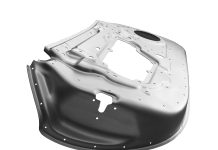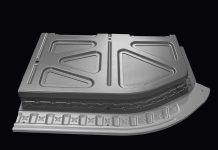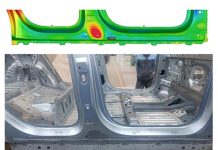What if a Live Link Could be Established Between Part Design, Process Layout and Cost Calculation to Bring About Revolutionary Cost Engineering?
[dropcap]I[/dropcap]n this interview the integration of software for cost engineering is addressed by Axel Maurer, Senior Consultant at AutoForm and specialist for Implementation of Planning and Bidding Solution. This is part two of our ‘PBS Value Engineering Series.’
Planning and Bidding Solution (PBS) is a hot item in the auto industry, promising to fulfil several still unmet demands from OEMs. Here Axel explains how OEMs use this tool to include real-time cost and engineering adaptions to achieve accurate value engineering in cost planning during complete product development process. If you missed the introduction interview you can find it HERE. ‘As seen in our last post we must firstly consider the OEM’s process chain, starting with concept styling, then product design, tool manufacturing, etc. concluding in part production at the end’ says Axel. ‘In a calculation system that meets reality you need to receive real-time figures. This needs to be updated, seeing that at any moment things change during part development. Early on they are limited to a rough idea of part cost, based on first geometries, draft blank size, and plans such as volume (how many cars will be produced in the first two years).’ ‘But a perfect PBS must include the ability for ‘regular updating of real figures.’ Consider that the initial part geometry develops over several months as the project evolves. As the part is constantly improved the product changes must be reflected in terms of cost. AutoForm-PBS is able to report that seeing that there is a live link between part design, process layout and cost. For example if a tool was first designed with a draft process layout for four operations, but engineers realized it must be formed with five, then the cost change must be reflected. Believe me when I say this adds significant cost changes. Such updates can occur several times during the preparation a car’s panels.’ 
Any change in the process plan will lead to automatic updates to the tooling cost.
‘Cost evaluators need to perceive cost from the start however. Their specific interest is in fast set up and getting early cost projections, even armed with limited information they will still begin extracting cost figures. This initial calculation is drawn from merely importing the CAD data for its part geometries. Even if it’s not yet finalized they’ll start calculating now. They do not yet have a final process layout and at this phase will now generate cost figures in order to examine their draft idea. At this phase the accuracy of such a calculation is acceptable to them as they desire a ball park figure.’ (rough estimate) ‘Your cost projections improve as they continue to reflect the ongoing level of quality input. Here cost engineers gain more insight as live updates are fed into PBS throughout development of all such factors that influence cost, including part changes, process layout and tool changes etc. which is why PBS is so important. Our competition cannot do this; our software works with initial limited-input all the way through. Therefore, as more information becomes available the calculation becomes more accurate. As they progress they add details such as the press data or a more optimized process layout etc. so that as part design and process layout mature, so too will cost calculations become more accurate.’ Here is one more interesting thing. In fact each OEM needs to customize their typical standards in process layout and die base assembly, configuring their PBS according to their own operational standards such as reference process layouts , die base assembly and production specifications. And in addition, of course each of them will have a different cost for 1kg of steel. 1 hour at the milling machine is also individual, as is their productivity in their process activities e.g. engineering, milling, die assembly and tryout. Therefore all their operational standards and productivities have to be worked in as customized configurations within an accurate PBS. When arriving to the milestone of “final part release” each OEM has entered their finalized and complete stamping data (e.g.: final released part, final process layout, final tool size and die base assembly, etc.) resulting in high accurate and fully customized cost calculations. So how does this look in practice, when brought into operation? ‘Every OEM uses their-own preferred IT-solutions. They use ERP systems like SAP and some manage their own custom-built data systems. PBS may be linked to all of these. The end game results in data being generated within the entire organization and it becomes incorporated into the PBS calculation systems. ProLeis another example of an ERP system that is popular with OEMs tool shops in Europe. It’s used to handle capacity planning (project plans for following days, weeks, months etc. for milling a.s.o.) and includes a recording system, whereby everything done in reality is recorded. This recorded real cost is an excellent base, that the configuration data for PBS should be base on, in order to realize maximum accuracy in the newest of cost calculation projects. 
Real-time cost calculation by use of AutoForm PBS and optional implementation of state-of-the-art calibration network
‘Ultimately, what we have achieved is a successful and powerful link between part geometries, process layout and the live updating of actual cost from reality’ says Axel. ‘It is one system only. Imagine the power of having that at your fingertips. If anyone was to do a change to the part design or process layout or die base assembly, this will update the data in PBS to generate an updated cost. We are talking about a very powerful link between part geometry, process layout and the resulting tool costs. Without doing anything, one updates the others. It’s tied into a single system. It’s one system only, uniting all important requirements to functionality and customizability. None of our competitors have achieved this. We are the only ones.’ ‘There are many requirements to achieve a total cost minimization and the fact is: they are only achieved in one software today. Factors such as the flexibility for reduced or complete input, the possibility to respect customer operating standards, the link between part design, process layout and die base assembly, and the ability to use customized configuration data based on real recorded cost data makes AutoForm PBS the most comprehensive and market favorite. Without incorporating all these factors you could not possibly achieve authentic planning and bidding calculations. You need an easy to use system, that is fast and transparent, and lastly you need accuracy, which can only be done through having calibration with a Cost-Recording-System. Such a PBS system is able to support all the needs in the entire process chain. No other software is able to do that.’ Thank you Axel for this insightful interview. New readers, stay in touch by subscribing to our blog.













